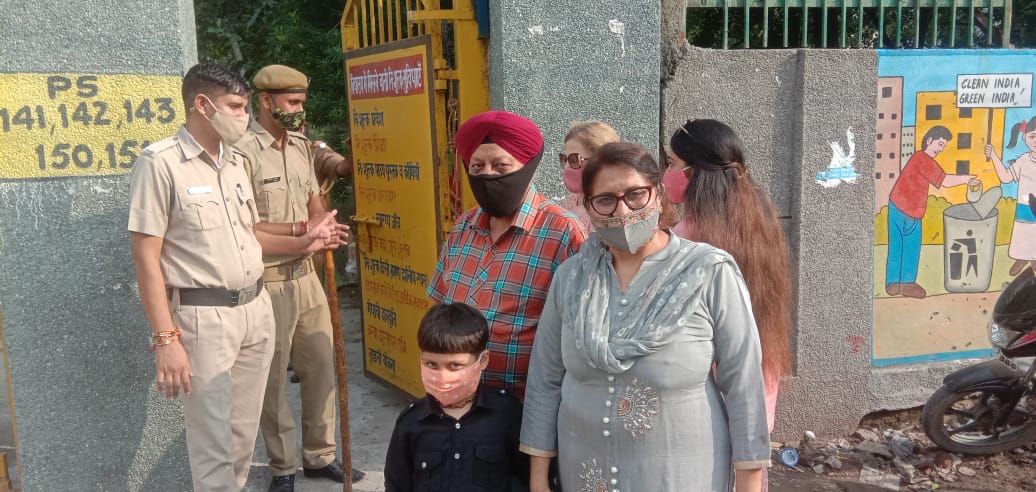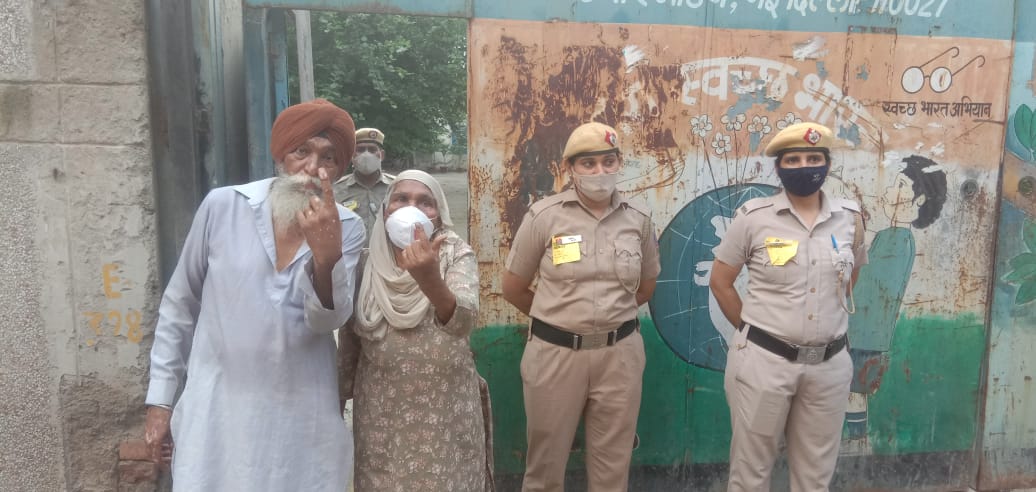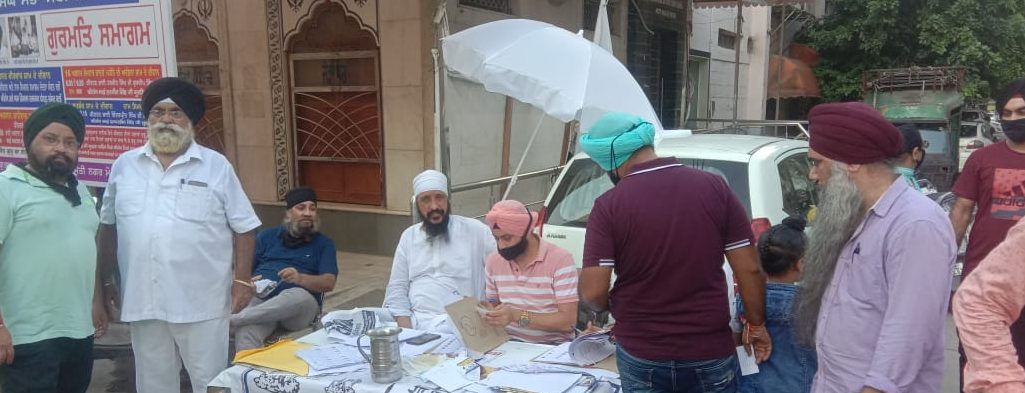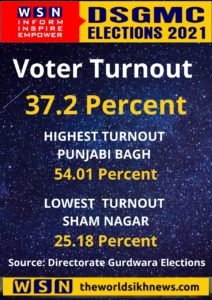37.27 percent Delhi Sikhs cast votes for DSGMC elections
By 25 August evening, it will be clear as to who will become the administrator and custodian of the Delhi Sikh Gurdwara Management Committee. 37.27 per cent of the Delhi Sikh citizens exercised their right to franchise, mostly in the post-luncheon session of the day amidst speculations that the Badal Dal had faced tough opposition. While many groups are upbeat about their chances, everyone has to wait with fingers crossed to know the outcome of this election which once again saw an overall low voter per cent, even much less than the 2017 turnout of 45.68 per cent. WSN Delhi Desk’s Gurmeet Singh reports.
![By 25 August evening, it will be clear as to who will become the administrator and custodian of the Delhi Sikh Gurdwara Management Committee. 37.27 per cent of the Delhi Sikh citizens exercised their right to franchise, mostly in the post-luncheon session of the day amidst speculations that the Badal Dal had faced tough opposition. While many groups are upbeat about their chances, everyone has to wait with fingers crossed to know the outcome of this election which once again […]](https://www.theworldsikhnews.com/wp-content/uploads/2021/08/Slider-for-DSGMC-Election-360x171.jpg)
VOTING in the 46 constituencies in the 546 polling booths across Delhi, to decide the fate of 312 candidates in 46 constituencies of the DSGMC, progressed very slowly with an abysmal low of less than 10 per cent in the first half of the day. Some wards showed a reasonable turnout whereas others presented a grim picture. The overall turnout of 37.27 per cent was much less than that polled in 2017, which was 45.68 per cent. The total votes polled were less by 8 per cent as compared to the last election, four years ago.
Raksha Bandhan had its impact in the first half of the day when the voting percentage was very low. As the numbers picked up in the second half, candidates and concerned Sikhs heaved a sigh of relief. Speaking to the WSN, Narender Singh, Director of Directorate Gurdwara Elections, informed that the total polling was 37.27% with Punjabi Bagh being the highest polling ward with 54.01% and Sham Nagar being the lowest polling ward with 25.18%.

Punjabi Bagh is a key constituency that saw a contest between DSGMC President Manjinder Singh Sirsa of the Badal Dal and Shiromani Akali Dal Delhi co-chief Harvinder Singh Sarna. The winner of this seat will likely be the next President of the Delhi-based apex body if their party or alliance is able to secure 24 or more seats out of the 46 wards.

Tri Nagar ward reported polling of 51.21%, Hari Nagar 50.46%, Lajpat Nagar 50.69% and Guru Harkrishan Nagar 48.37%. Surprisingly, the densely populated Sikh areas of Sham Nagar, Vishnu Garden, Khyala and Ravi Nagar polled very less with 25.10%, 28.70%, 25.65% and 25.44% respectively. This one big cluster of adjacent areas in West Delhi has 4 wards of DSGMC because of the high population of Sikhs residing here. Low voter turnout here is a reflection of the minimal interest taken by the residents of the area in the DSGMC elections.

When this correspondent spoke to Natha Singh of the JAGO party in the Sham Nagar constituency, which reported the lowest turnout amongst all wards, he was very confident of his prospects, as he claimed that he had given a tough fight to Harjeet Singh of the Badal Dal.
Sarna scion Prabhjit Singh Sarna, while speaking to WSN was positive of the win of the Shiromani Akali Dal Delhi.
“Influenced by the WSN campaign, I voted for the first time in the DSGMC election.”
Malkinder Singh, candidate of the pre-poll alliance of Panthak Akali Lehar and Shiromani Akali Dal Delhi, from the Tagore Garden ward, rued the fact that the voter turnout was less than his expectations in parts of the constituency, but he was confident that the Sikh Sangat will return him again in view of his “work and relationships with the Sangat.”
Candidates and cadres now have two days to rest before the nerves go high on the day of results -25 August 2021. The Directorate of Gurdwara Elections will be on its toes till the results are announced and till the new committee officially takes charge by the end of this month on 31 August 2021.
Though there have been large-scale reports of distribution of largesse to influence voters in many constituencies, almost by all groups and candidates, fortunately, there was no internecine violence during the polls.
Out of a total projected population in Delhi of 600,000, based on decennial growth, taking the 2011 Census data as the base (as there has been no Census in 2021 due to COVID19), only 342,065 Sikhs registered as voters. From amongst them, 127,472 voted on 22 August, to decide the fate of 46 prospective custodians, who will make decisions on a budget of Rs. 150 crores and preside over the management of Sikh historical Gurdwaras, institutions, schools, a hospital, pilgrim inns and of course, the public image and status of the Sikhs.
A part of me was happy that despite the threat of Covid19 and the Raksha Bandhan festivities, a good 37 per cent of the electorate had come out of their homes to vote. Also, though there have been large-scale reports of distribution of largesse to influence voters in many constituencies, almost by all groups and candidates, fortunately, there was no internecine violence during the polls.
Only 128,581 Delhi Sikh voters will make decisions on a budget of Rs. 150 crores and preside over the management of Sikh historical Gurdwaras, institutions, schools, a hospital, pilgrim inns and of course, the public image and status of the Sikhs.
 WSN is conscious that despite its best efforts to launch a comprehensive social media campaign to excite Sikh voters, the voter turnout was less than expected. However, we take solace from the fact that we were able to impact the registration of votes and also many new voters were influenced by the WSN campaign.
WSN is conscious that despite its best efforts to launch a comprehensive social media campaign to excite Sikh voters, the voter turnout was less than expected. However, we take solace from the fact that we were able to impact the registration of votes and also many new voters were influenced by the WSN campaign.
Leading Delhi High Court and Supreme Court lawyer -Harpreet Singh Hora, acknowledged, “Influenced by the WSN campaign, I voted for the first time in the DSGMC election.” Another senior Sikh stalwart said, “Thank you WSN for enabling us to register votes of all our family members. We all voted today.”
Yet, at the end of the day, I could hear my own voice telling me, “You get what you deserve.”


 145
145


